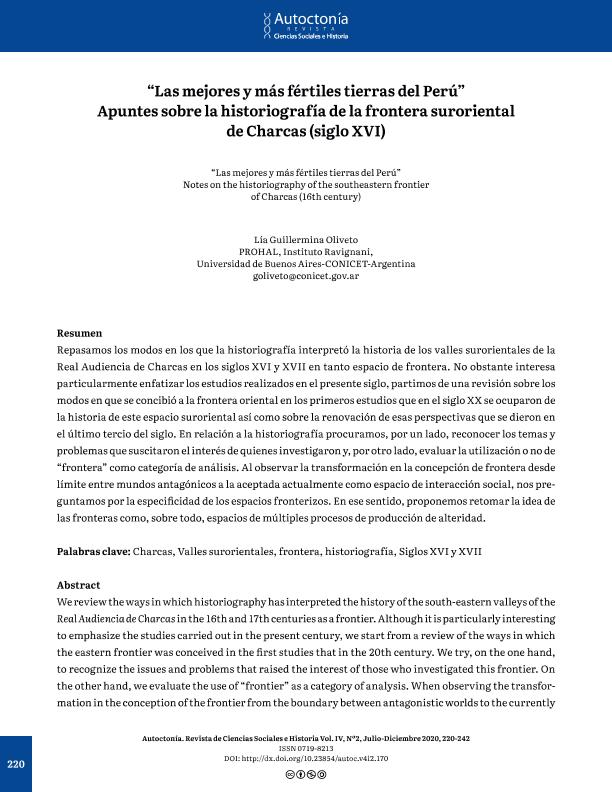Artículo
Repasamos los modos en los que la historiografía interpretó la historia de los valles surorientales de la Real Audiencia de Charcas en los siglos XVI y XVII en tanto espacio de frontera. No obstante interesa particularmente enfatizar los estudios realizados en el presente siglo, partimos de una revisión sobre los modos en que se concibió a la frontera oriental en los primeros estudios que en el siglo XX se ocuparon de la historia de este espacio suroriental así como sobre la renovación de esas perspectivas que se dieron en el último tercio del siglo. En relación a la historiografía procuramos, por un lado, reconocer los temas y problemas que suscitaron el interés de quienes investigaron y, por otro lado, evaluar la utilización o no de frontera como categoría de análisis. Al observar la transformación en la concepción de frontera desde límite entre mundos antagónicos a la aceptada actualmente como espacio de interacción social, nos preguntamos por la especificidad de los espacios fronterizos. En ese sentido, proponemos retomar la idea de las fronteras como, sobre todo, espacios de múltiples procesos de producción de alteridad. We review the ways in which historiography has interpreted the history of the south-eastern valleys of the Real Audiencia de Charcas in the 16th and 17th centuries as a frontier. Although it is particularly interesting to emphasize the studies carried out in the present century, we start from a review of the ways in which the eastern frontier was conceived in the first studies that in the 20th century. We try, on the one hand, to recognize the issues and problems that raised the interest of those who investigated this frontier. On the other hand, we evaluate the use of “frontier” as a category of analysis. When observing the transfor-mation in the conception of the frontier from the boundary between antagonistic worlds to the currently accepted definition as space of social interaction, we ask ourselves about the specificity of frontier spaces. In this sense, we propose to think in frontiers, as spaces of multiple processes of production of otherness.
Las mejores y más fértiles tierras del Perú: Apuntes sobre la historiografía de la frontera suroriental de Charcas (siglo XVI)
Título:
Las mejores y más fértiles tierras del Perú: Notes on the historiography of the southeastern frontier of Charcas (16th century)
Fecha de publicación:
31/07/2020
Editorial:
Universidad Bernardo O'Higgins
Revista:
Autoctonía
ISSN:
0719-8213
Idioma:
Español
Tipo de recurso:
Artículo publicado
Clasificación temática:
Resumen
Palabras clave:
CHARCAS
,
VALLES SURORIENTALES
,
HISTORIOGRAFÍA
,
SIGLO XVI
Archivos asociados
Licencia
Identificadores
Colecciones
Articulos(INSTITUTO "DR. E.RAVIGNANI")
Articulos de INST. DE HISTORIA ARGENTINA Y AMERICANA "DR. EMILIO RAVIGNANI"
Articulos de INST. DE HISTORIA ARGENTINA Y AMERICANA "DR. EMILIO RAVIGNANI"
Citación
Oliveto, Lia Guillermina; Las mejores y más fértiles tierras del Perú: Apuntes sobre la historiografía de la frontera suroriental de Charcas (siglo XVI); Universidad Bernardo O'Higgins; Autoctonía; 4; 2; 31-7-2020; 220-242
Compartir
Altmétricas




